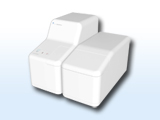Particle Size
Particle Size & Zeta
| Multi-Sample Nanoparticle Size Measurement System nanoSAQLA with Auto Sampler AS50 | |
|---|---|
|
|
This is a particle size measurement system (particle size 0.6 nm - 10 μm*) that uses the `dynamic light scattering method` (DLS method). |
| Multi-Sample Nanoparticle Size Measurement System nanoSAQLA | |
|---|---|
|
|
This is a particle size measurement system (particle size 0.6 nm - 10 μm*) that uses the `dynamic light scattering method` (DLS method). |
|
Zeta-potential & Particle size Analyzer ELSZneo |
|
|---|---|
|
|
ELSZneo is the high-end model of the ELSZ series. This instrument measures zeta potential and particle size of both diluted and concentrated solutions, and molecular weight of a polymer. As new features, ELSZneo provides a multi-angle measurement to improve the separability of particle size distribution, particle concentration measurement, microrheology measurement, and gel network analysis. |
| Zeta-potential & Particle size Analyzer ELSZ-2000 series | |
|---|---|
|
|
In addition to existing zeta potential and particle size measurement, molecular weight analysis function is newly added. (Particle size :0.6nm-10um/Concentration range: 0.00001%-40%). |
Particle Size & MW
|
Zeta-potential & Particle size Analyzer ELSZneo |
|
|---|---|
|
|
ELSZneo is the high-end model of the ELSZ series. This instrument measures zeta potential and particle size of both diluted and concentrated solutions, and molecular weight of a polymer. As new features, ELSZneo provides a multi-angle measurement to improve the separability of particle size distribution, particle concentration measurement, microrheology measurement, and gel network analysis. |
| Zeta-potential & Particle size Analyzer ELSZ-2000 series | |
|---|---|
|
|
In addition to existing zeta potential and particle size measurement, molecular weight analysis function is newly added. (Particle size :0.6nm-10um/Concentration range: 0.00001%-40%). |
| Dynamic Light Scattering Spectrophotometer DLS-8000 series | |
|---|---|
|
|
Measurement system for particle size and particle-size distribution using “dynamic light-scattering method” and absolute molecular weight, radius of gyration, and the second virial coefficient using and “static light-scattering method" |


 Close
Close









